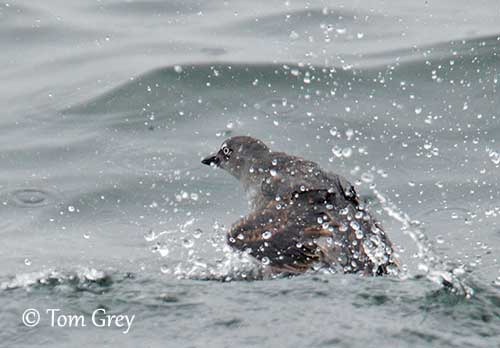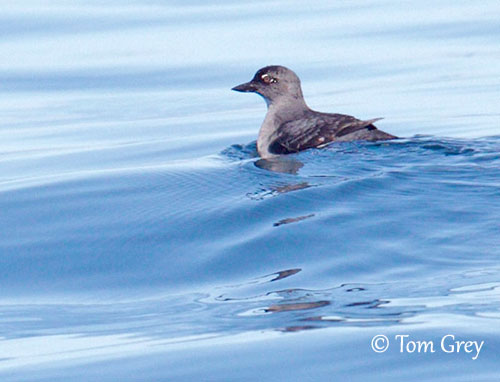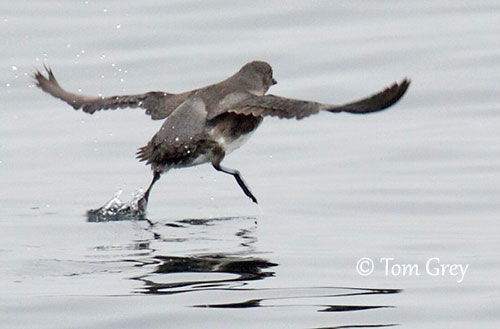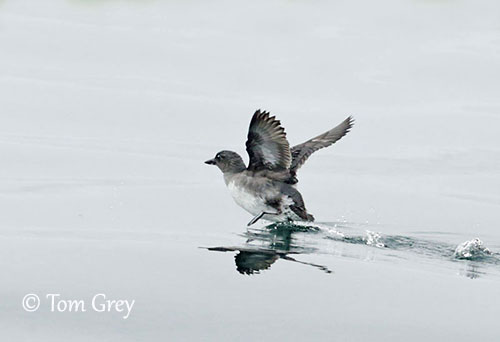
Fr: Starique de Cassin
Ang: Cassin’s Auklet
All: Aleutenalk
Esp: Mérgulo Sombrío
Ita: Alchetta di Cassin
Nd: Cassins Alk
Sd: Sotalka
Photographer:
Tom Grey
Tom Grey's Bird Pictures & Tom Grey's Bird Pictures 2
Text by Nicole Bouglouan
Sources:
HANDBOOK OF THE BIRDS OF THE WORLD Vol 3 by Josep del Hoyo-Andrew Elliott-Jordi Sargatal - Lynx Edicions - ISBN: 8487334202
A GUIDE TO THE BIRDS OF MEXICO AND NORTHERN CENTRAL AMERICA by Steve N. G. Howell, Sophie Webb - Oxford University Press - ISBN: 0198540124
FIELD GUIDE TO THE BIRDS OF NORTH AMERICA - National Geographic Society - ISBN: 0792274512
All About Birds (Cornell Lab of Ornithology)
Wikipedia, the free encyclopaedia
What Bird-The ultimate Bird Guide (Mitchell Waite)
Ministry of Environment – Cassin’s Auklet - Original prepared by Anne Harfenist
National Park Service - Cassin’s Auklet
Alaska Seabird Information Series
Living Oceans - Death on the beaches - The mystery of the Cassin’s auklets
Cassin’s Auklet
Ptychoramphus aleuticus
Charadriiformes Order – Alcidae Family
INTRODUCTION:
The Cassin’s Auklet is the only member of the genus Ptychoramphus and is a Pacific species present from Aleutians to Baja California. Unlike other Alcids, this species produces two broods per season, at least in the southern part of the range. Outside the breeding period, it is mostly pelagic.
The Cassin’s Auklet is gregarious all year round, feeding in flocks and nesting in colonies. It is vulnerable to introduced predators on breeding islands, disturbance and pollution at sea. It is currently listed as Near Threatened and the population is declining.
DESCRIPTION OF THE BIRD:
Biometrics:
Length: 23 cm
Wingspan: 34 cm
Weight: 150-200 g
The Cassin’s Auklet is a plump Alcidae with short, broad, rounded wings with pointed tips, well-adapted to its underwater foraging behaviour.
The adult has blackish to grey upperparts. On the underparts, breast and flanks are greyish-brown, while belly and vent are white. The squared tail is dark grey.
The rounded head is dark greyish-brown, whereas chin and throat are paler brown. There is a white crescent above and below the eye. The upper crescent is more conspicuous.
The black bill is short and pointed, with yellowish base of lower mandible. The eyes are silver-white. Legs and webbed feet are bluish-pink with black claws.
There is no marked seasonal variation and male and female are similar.

The juvenile has browner wings and tail and whiter throat. The intermediate-aged birds show a combination of brown and silver-white eyes, usually dark brown in chicks and juveniles.
SUBSPECIES AND RANGE:
The Cassin’s Auklet has two recognized subspecies.
P.a. aleuticus occurs in Aleutians Islands to SW and SE Alaska, and then S to N Baja California (on islands of San Gerónimo, San Martín and Guadalupe).
P.a. australis is found in W Baja California, from San Benito Islands, S to Asunción Island and San Roque Island.
This race is smaller overall.
They winter in the breeding range, usually offshore from S British Columbia to S Baja California. Some birds may winter N to Alaska.
The Cassin’s Auklet has now returned to Californian islands after eradication of black rats (Rattus rattus) in November 2002. This return is the result of a restoration program at Anacapa Island, in the Channel Islands National Park, California.
HABITAT:
The Cassin’s Auklet spends most of its life at sea where it occurs offshore and along the sea coasts, mainly over the continental shelf to the edge. However, it also occurs beyond into deeper ocean.
It colonizes numerous sea islands where it breeds, and uses any type of areas such as barren, forested, with steep slopes or flat areas.
During winter, the southern birds usually remain inshore near the breeding colonies. The other populations winter offshore but within the breeding range. It can be seen in upwellings over the continental shelf and also in deeper waters.

CALLS AND SONGS: SOUNDS BY XENO-CANTO
The Cassin’s Auklet gives a weak croaking at night on the breeding grounds, usually a hoarse, slightly rough, purring “ruh reehr” or “uhr rreihr”. This call is repeated a few times and often becomes a full chorus when numerous birds are involved.
BEHAVIOUR IN THE WILD:
The Cassin’s Auklet feeds primarily on small planktonic crustaceans including copepods and euphausiids, and it also feeds on larvae fish. But the diet may vary depending on the range. Amphipods, squid and small fish are taken too.
The winter diet is unknown, but crustaceans are probably taken all year round.
The Cassin’s Auklet forages by swimming underwater by day or night, propelled by its wings. It often forages in small groups and occasionally in larger flocks but rarely alone. It can dive to depths of 20-80 metres during about 40-42 seconds.
The pair forms in late winter. The Cassin’s Auklet performs courtship displays including series of mutual bowing, also head-bobbing by moving the head from side to side, and touching bills.
They nest in burrows excavated in soil by both mates. They are monogamous and often reuse the same burrow in several following years.
The Cassin’s Auklet winters offshore, but remains within the breeding range. The southern population is mainly sedentary and usually remains at sea near the colonies.
The populations of Alaska and British Columbia migrate S along the coast to California. They leave their wintering areas as early as December, but more often in January/February. They reach the breeding grounds in N range in March/April.
The movements are closely related to squid, fish and planktonic crustaceans’ abundance.
The Cassin’s Auklet performs low, heavy, direct flight. Before to take-off, it patters along the water surface.

REPRODUCTION OF THIS SPECIES:
The breeding season varies throughout the range, related to oceanographic conditions. The laying occurs early March to late April in C California (Farallon islands), mid-April to late May in British Columbia, and early June to early July in Alaska.
The Cassin’s Auklet is the only Alcidae species to produce two broods per season, but mostly in California. It is highly colonial and nests in colonies from 500 to more than 1,000,000 birds, and at high density with one pair/m² at the best sites.
The colonies are established on maritime grassy slopes, on inland flat bare ground or in areas with trees or shrubs. Both adults excavate the burrow, but they also use crevice, cavity, hole or cave. In the burrow, the nest-chamber is sometimes lined with pieces of vegetation.
The female lays a single creamy-white egg, and both adults incubate during 38-39 days, sometimes up to 57 days. At hatching, the chick has brown eyes, black to dark grey down above and paler grey below. It is semi-precocial. It is fed at night by both parents inside the burrow. The adults regurgitate partially digested food carried in a sublingual pouch. The young fledges about 40-50 days after hatching, and leaves the burrow and the colony alone and before dawn to reach the ocean. It is able to swim and dive immediately.
PROTECTION / THREATS / STATUS:
The Cassin’s Auklet is vulnerable to disturbance and introduced predators on the breeding islands. At sea, oil spills and other pollutions kill numerous birds every year. Bycatch in fishing nets is a serious threat, and in addition, the birds attracted to lights on boats often kill or injure themselves in collisions. Recreational activities involve disturbance too.
This species is vulnerable to El Niño effect that moves the planktonic organisms eaten by the Cassin’s Auklet, involving the death of thousands of birds by starvation.
The global population is estimated at least at 3,600,000 breeding birds, equating approximately 5,400,000 individuals. This population is still declining, and currently, the Cassin’s Auklet is listed as Near Threatened.
